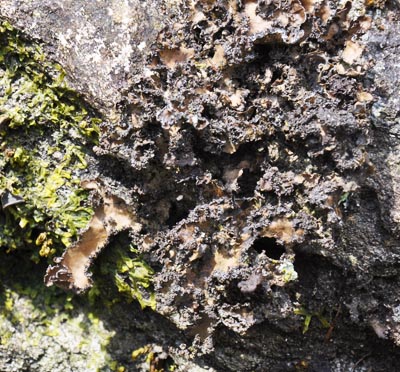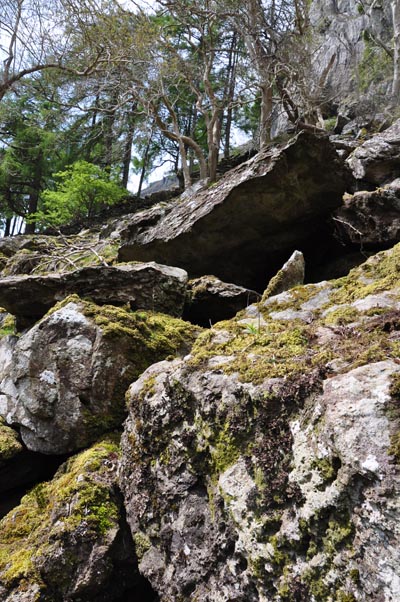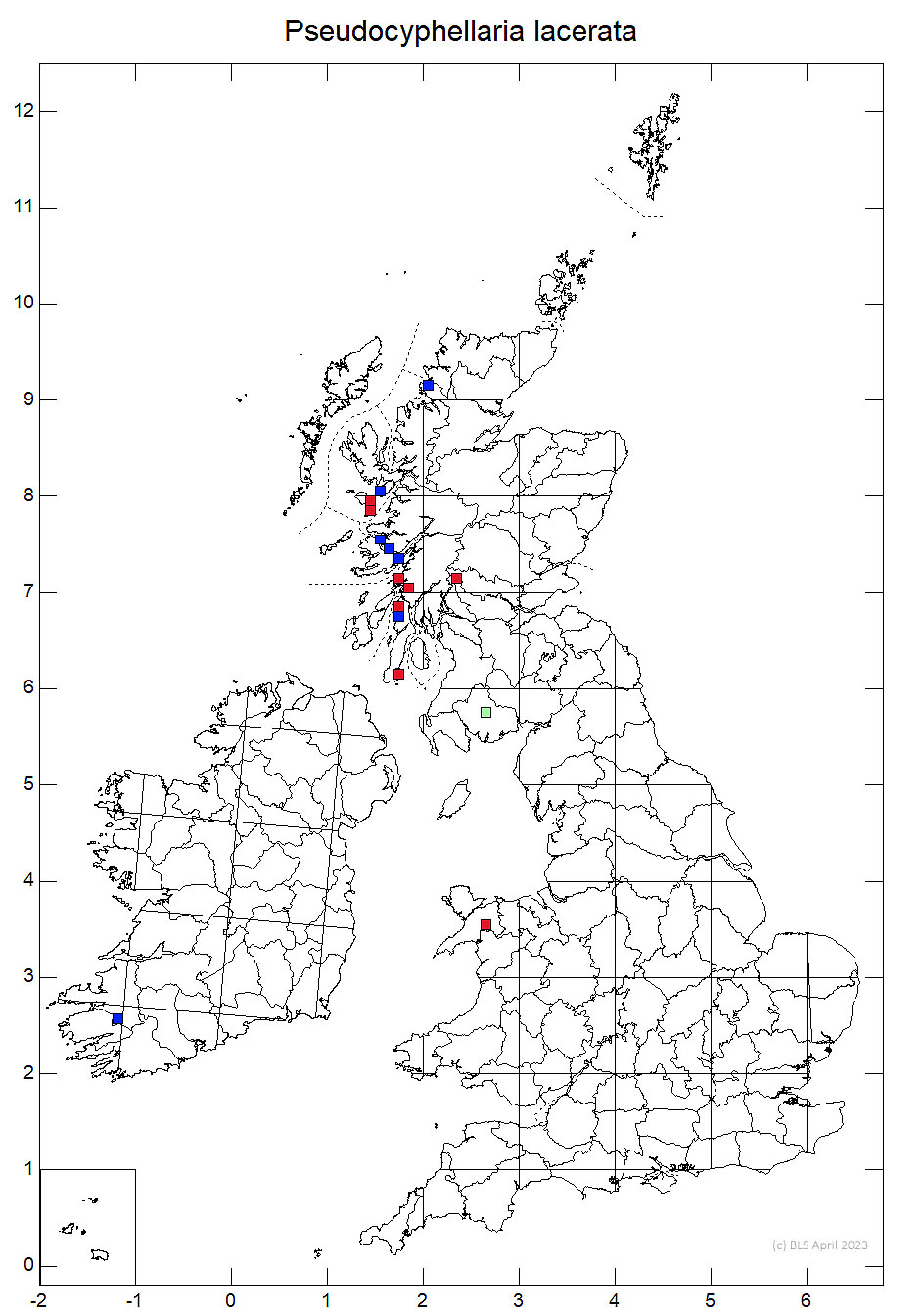This species was described new to science in 1941 by Degelius from material collected in the Azores (see Galloway (1994)). It closely resembles P. intricata, and is a substantial foliose lichen with, when moist, a brown thallus that becomes grey-brown on drying out. Its surface is smooth, though it may develop ridges. Instead of the purple grey coloured eruptions of soralia along the lobe margins of the thallus of P. intricata this species develops marginal simple or branched cylindrical coral-like isidia that occasionally extend onto the thallus surface. It might be mistaken for a Nephroma or a Peltigera. The underside gives it away in that the Pseudocyphellaria is covered in a dense, dark brown stubble of rhizines. A careful search amongst the rhizines will also reveal the presence of small sunken bald patches, the pseudocyphellae that give it its generic name and the English name of the Americans-the speckle bellies. Peltigera has large bushy, rather widely spaced rhizines and Nephroma a bare undersurface. Similar Sticta species smell distinctly of fish when moist.
 |
 Sm.jpg) |
| Photos: Liz Fleming-Williams | |
PLEASE NOTE. All Pseudocyphellarias appear to be exceptionally rare in Wales and you must not just rip up bits to look at the underside!! In dry weather take a small sprayer and water with you to moisten the thallus before carefully turning it over in situe. An illuminated hand lens is almost a must.
P. norvegica differs in having a C+ red and KC+ orange medulla and is sorediate. Its lobes are somewhat more rounded and ridged than the superficially similar P. intricata and there are more soralia scattered over the thallus surface. Unfortunately occasionally P. intricata soredia can grow in situe to develop a cortex and so resemble isidia and there is indeed doubt cast by some (eg Ahti et al (eds.) (2007) that any British material is this species. If in doubt seek expert help.
Note also that P. lacerata is protected by Schedule 8 of the Wildlife & Countryside Act and a licence must be obtained before any material can be collected.
It lives on somewhat basic mossy trunks and boulders in woodland or sheltered ravines in humid, oceanic areas. It is usually found in sites with a well-developed Lobarion community. In Scotland it rarely occurs over 110m being mostly a species of coastal ravines. In Wales its only known site is at around 100m.

Photo: Liz Fleming-Williams
At this one Welsh site it is found on a nearly vertical slightly basic boulders in wooded block scree. In 2000 the following species were noted as associates to 5 adjacent colonies:
Neckera crispa, Metzgeria furcata, Pterogonium gracile, Ctenidium molluscum, Thuidium tamariscinum, Lejeunea patens, Porella arboris-vitae, Plagiochila spinulosa, Sedum anglicum, Epilobium nerterioides and Geranium robertianum. Around a large colony 17 x 10cm in extent the following species were noted: Pterogonium gracile, Isothecium myosuroides, Frullania sp. Metzgeria furcata, Ctenidium molluscum, Sticta sylvatica and Leptogium cyanescens/britannicum. In 2010 a 25cm square around the only population discovered contained the following species with their percentage covers. Pseudocyphellaria lacerata 15, Metzgeria furcata 8 Sticta sylvatica 5, Peltigera horizontalis 5, Fissidens adianthoides 3, Trapelia placodioides 3, Leptogium sinuatum 3, Lecidella stigmatea 1, Normandina pulchella 1, undetermined crustose lichens 25.
The first record from Wales is that of K. A. Kershaw who collected a specimen in the “Nant Gwynant Pass on a wet rock face in woodland” in 1961 that is held in the Natural History Museum and was subsequently determined as this species by Peter James. This record prompted a visit organised by Annie Seddon and accompanied by the author, Peter Benoit and Andrew Graham and his sister to search this valley in 2000 when a population was discovered close to the head of Llyn Gwynant. It was refound by the author and E. Fleming-Williams in 2010. At this one Welsh locality it occurs on a basic rock in open ash/hazel. This wood is probably one of the wettest in Wales. The block screes here support a fine Lobarion community but in the high rainfall many of the trees appear to be mostly too acidic for this community. There are no other localised Welsh records. Pentecost (1987) does not report this species from Gwynedd.
Coppins and O’Dare (1995) report its distribution in Scotland where it has been found in 3 sites, though it had only recently been seen in 2. It occurs on Mull and in Kintyre. Subsequently a scatter of other localities have been discovered in the West Highlands
Galloway (1994) provides a world distribution map indicating records from SW Ireland, the Faeroes (in the 1800’s), Madeira and the Azores. It should also be noted that Ahti et al (eds.) (2007) disclaim the record from the Faeroes and the British Isles maintaining that specimens from these areas are an isidiate form of P. intricata. Gene sequencing is desirable to help settle this uncertainty.
With its current known Welsh population consisting of just one thallus 5cm across and two smaller thalli on one boulder and a very small thallus on an adjacent rock, this species is considered Critically Endangered in Wales. In 2000 6 colonies were noted. The largest measured 17cm across at its widest. The 2010 search was not exhaustive and the differences in the associated species recorded between 2000 and 2010 are such that two completely different clusters of colonies might exist here. Even if this is the case it remains critically endangered. The site lies close to a campsite and the edges and part of the block scree receive intense public usage. A close watch is required to ensure new paths through the scree are not created. The land is believed to be in private ownership and no right to roam exists as it is woodland. The area is grazed by goats and probably seasonally by sheep. They may, through trampling, detach colonies but since most lichen colonies appear to be on vertical surfaces the risk is slight. In the absence of grazing higher plant growth may shade the lichen. Neither ivy, holly or rhododendron appear to threaten the site. As a base-loving species in a very high rainfall area acid rain may be severely limiting its ability to colonise trees and some of the less basic rocks.
In Britain it is considered to be Vulnerable. It is a BAP species and is listed on Schedule 42 of the NERC Act in Wales. British populations are considered to be of International Importance.
Ahti et al (eds.), (2007). Nordic Lichen Flora Vol 3. Nordic Lichen Society, Uppsala.
Coppins, AM & Coppins, BJ (1995). Pseudocyphellaria lacerata Species Dossier. A report to Scottish National Heritage and the Royal Botanic Garden Edinburgh.
Coppins, BJ & James, P (1979). New or Interesting British Lichens. Lichenologist 11: 139-179.
Galloway, D.J., (1994). Pseudocyphellaria lacerata, New to the Faeroe Islands. Lichenologist 26(4) 391-393.
Pentecost, A (1987). The lichen flora of Gwynedd. Lichenologist 19:1-166.
Rose, F, and James, PW (1998). Pseudocyphellaria lacerata. Species account 1197/1998 in the third fascicle of the Lichen Atlas of the British Isles. British Lichen Society, London.
- Log in to post comments

